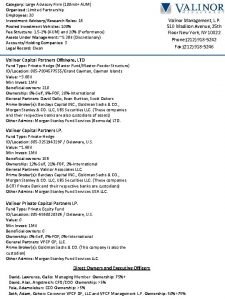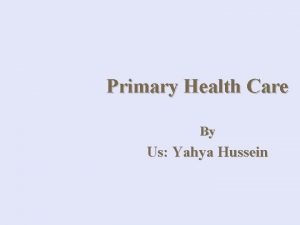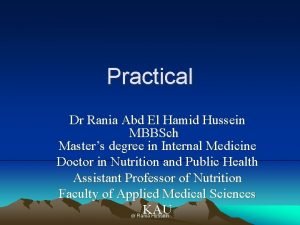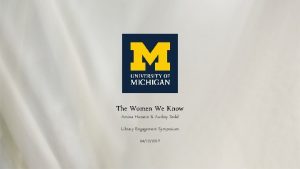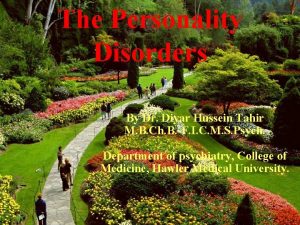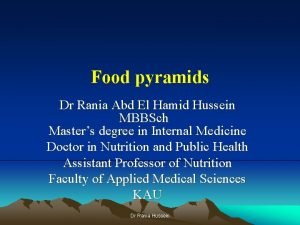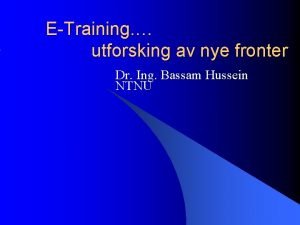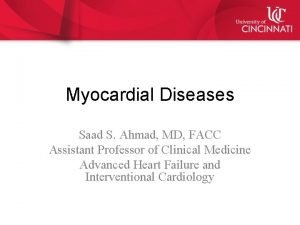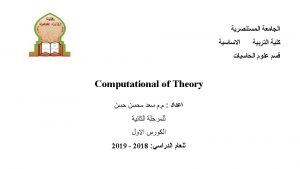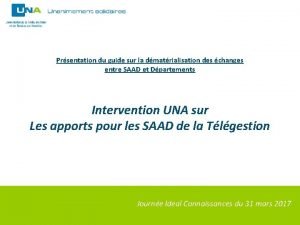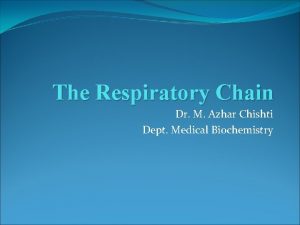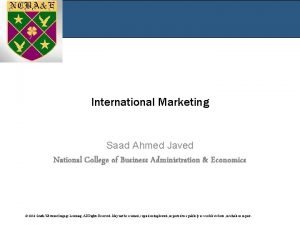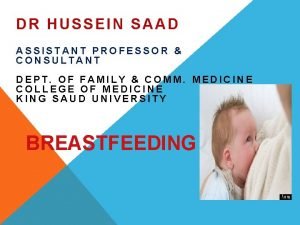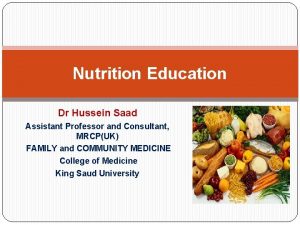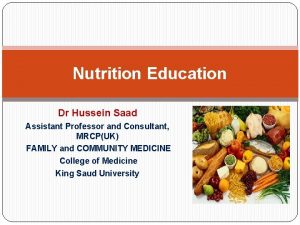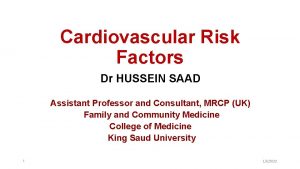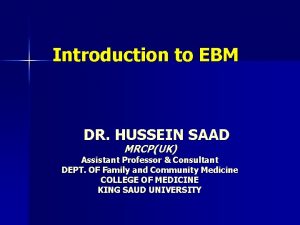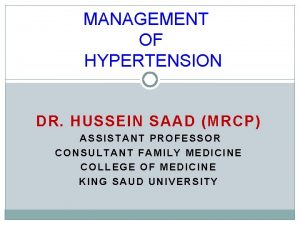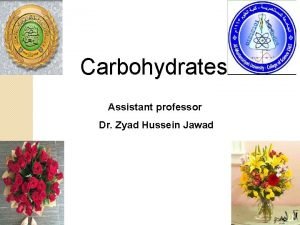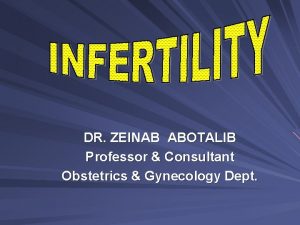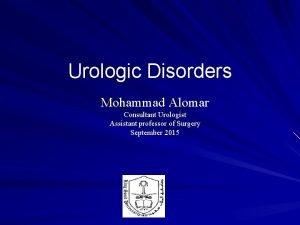Dr Hussein Saad Assistant Professor Consultant Dept of


















































- Slides: 50

Dr Hussein Saad Assistant Professor & Consultant Dept. of Family & Comm. Medicine College of Medicine king Saud University BREASTFEEDING Reproductive Block

OBJECTIVES q. To be aware of WHO recommendation q. To increase awareness about the benefits of breastfeeding. q. To know about the properties of breastfeeding. q. To educate about the basics of breastfeeding and empower parents to make an informed choice. q. To educate about the harms associated with formula feeding. q. To know how can you deal with Breast Engorgement q. To know about the contraindication of breastfeeding


The Baby-Friendly Hospital Initiative Provides guidance on the implementation, training, monitoring, assessment and re-assessment of the Ten Steps to Successful Breastfeeding and the International Code of Marketing of Breast-milk Substitutes, a set of recommendations to regulate the marketing of breast-milk substitutes, feeding bottles and teats adopted by the 34 th World Health Assembly (WHA).

Skin-to-Skin Contact • Is when the infant is placed prone on the mother’s abdomen or chest in direct ventral-to-ventral skin-to-skin contact. • Immediate skin-to-skin contact is done immediately after delivery, less than 10 minutes after birth. • Early skin-to-skin contact was defined as beginning any time from delivery to 23 hours after birth. • Skin-to skin contact should be uninterrupted for at least 60 minutes. The infant is thoroughly dried and kept warm (for instance by being covered across the back with a warmed blanket).

Early initiation of Breastfeeding q Involves a breastfeeding initiation time of within 1 hour after birth. q Delayed breastfeeding initiation means initiating breastfeeding after the first hour after birth (2– 23 hours after birth or a day or more after birth).

Timing of breastfeeding initiation: Early breastfeeding: if initiated to baby within the first one hour of birth. Delayed breastfeeding: if the time of the first breastfeeding initiation is more than one hour after birth). Child Development Research Volume 2013 (2013), Article ID 530396, 9 pages

Showing Mothers how to Breastfeed q. Is a supportive interventions that enable mothers to breastfeed successfully. q. This support usually involves showing mothers how to hold and position their infant to attach to the breast.

A good Breastfeeding Latch • The ideal latch encompasses both the nipple and the surrounding areola. • A proper latch if the baby's chin and tip of nose are touching breast. • Clamping down just on the nipple is not only inefficient for drawing out milk but can also cause nipple damage and pain. Why a good breastfeeding latch is important • A good latch is the foundation of successful breastfeeding. It allows your baby to feed freely, and stop when satisfied. • It's also the only way to make breasts are stimulated to produce more milk.

Showing Mothers how to Express Breast milk q. To reassure mothers that milk is being produced by their breasts (particularly in the first few days after birth). q. To enable a mother to provide breast milk in the event, that she will need to be separated from her infant. v. Expression of breast milk is primarily done or taught through hand expression, by placing the thumb and fingers around the areola. v. The use of a mechanical pump only when necessary.

Rooming-in q. Involves keeping mothers and infants together in the same room, immediately after leaving the labour room after a normal facility birth or from the time when the mother is able to respond to the infant, until discharge. q. This means that the mother and infant are together throughout the day and night, apart from short intervals when the mother has a specific need, for instance, to use the bathroom.

Demand Feeding q. Involves recognizing and responding to the infant’s display of hunger and feeding cues and readiness to feed. q. Demand, or baby-led feeding puts no restrictions on the frequency or length of the infants’ feeds, or the use of one or both breasts at a feed. q. Mothers are advised to breastfeed whenever the infant shows signs of hunger, or as often as the infant wants.

Avoidance of Pacifiers or Dummies q. Involves advising mothers to avoid offering pacifiers or dummies and may, in addition, involve teaching mothers alternative methods to calm and soothe their infants. q. Unrestricted pacifier use means that pacifiers or dummies can be offered liberally to infants to suck on during their stay at the facility providing maternity and newborn services.

Avoidance of Feeding Bottles and Teats Involves offering oral feeds (of expressed breast milk or, when medically indicated, a combination of expressed breast milk and other fluids) without using feeding bottles and teats, but instead feeding by cup, dropper, or spoon when the infant is not on the breast.

Creating an Enabling Environment • Breastfeeding policies in facilities providing maternity and newborn services need to cover all established standards of practice and be fully implemented and publicly and regularly communicated to staff. • Training of health workers enables them to build on existing knowledge and develop effective skills, give consistent messages and implement policy standards according to their roles.

Creating an Enabling Environment • Antenatal breastfeeding education for mothers can encourage discussion, help prepare mothers practically and promote initiation of breastfeeding after delivery. It may include counselling and information given in a variety of ways. • Discharge planning and linkage to continuing support: before discharge from the facility providing maternity and newborn services, it is necessary to plan for breastfeeding after discharge and to provide linkage to continuing and consistent support outside the facility, to help mothers to sustain breastfeeding.

WHO/UNICEF Ten Steps to Successful Breastfeeding 1. Have a written breastfeeding policy communicated to all health care staff. 2. Train all health care staff to implement this policy 3. Inform all pregnant women about benefits of breastfeeding 4. Initiate the breastfeeding within the first hour 5. Show mothers how to breastfeed and how to maintain lactation 6. Give newborn infants no food or drink other than breast milk, unless medically indicated 7. Allow mothers and infants to remain together 24 hour a day 8. Encourage breastfeeding on demand 9. Give no artificial nipples or pacifiers to breastfeeding infants 10. Foster the establishment of breastfeeding support groups and refer mothers to them on discharge from hospital

RECOMMENDATIONS OF WHO q Exclusive breastfeeding until 6 months of age q Introduce complimentary foods with continued breastfeeding up to 2 years. In addition: v. Breastfeeding should begin within one hour of birth. v. Breastfeeding should be "on demand", as often as the child wants day and night; and v. Bottles or pacifiers should be avoided. v. Breastfeeding should not be decreased when starting on solids.

Sub-Optimal Breastfeeding • Around 32% of children less than 5 years of age in developing countries are stunted and 10% are wasted. • It is estimated that sub-optimal breastfeeding, especially non -exclusive breastfeeding in the first 6 months of life, results in 1. 4 million deaths and 10% of the disease burden in children younger than 5 years. • World Health Organization. The global burden of disease: 2004 update. Geneva, World Health Organization, 2008.


DHS and other national household surveys, around 1995 to around 2010, with additional analysis by UNICEF.

How often should I breastfeed and how long should a feeding last? • A woman should breastfeed when her baby shows signs of being hungry. A baby can show that he or she is hungry by: q. Waking up from sleep. q. Moving the head around as if he or she is looking for the breast. q. Sucking on his or her hands, lips, or tongue.

How do I know if my baby is getting enough breast milk? • You can tell if your baby is getting enough breast milk by: q. Checking his or her diapers – By day 4 or 5 after birth, babies should have at least 6 wet diapers a day. q. Checking his or her bowel movements – By day 4 after birth, babies should have 4 or more bowel movements a day. By day 5, their bowel movements should be yellow. q. Having your doctor or nurse check to see if your baby is gaining weight.

PROPERTIES of BREASTMILK q. Biologic specificity => Long-chain omega-3 Fatty Acids q. Important for brain and retinal development q. Higher Iqs (a meta-analysis of 20 studies showed scores of cognitive function on average 3. 2 points higher among children who were breastfed compared with those who were formula fed)

MILK VOLUME q Healthy exclusively breastfeeding women produce approximately 750 to 800 m. L per day of milk when lactation is fully established. q. However, milk volume varies among individuals and can range from 450 to 1200 m. L per day. q. Milk volume is low on the first two days postpartum, increases markedly on days three and four, then gradually increases to levels seen in full lactation.

BREAST MILK COMPOSITION Protein: The concentration of protein in breast milk (0. 9 g per 100 ml) is lower than in animal milks. Fat: (3. 5 g per 100 ml) provides up to 50% of caloric needs, cholesterol levels constant, lipolytic enzymes aid in fat digestion). Carbohydrates: (lactose = milk sugar) predominantly in human milk (7 g per 100 ml) provides up to 40% caloric needs, essential for development of CNS, enhances calcium & iron absorption).

BREAST MILK COMPOSITION Vitamins and Minerals • Breast milk normally contains sufficient vitamins for an infant, unless the mother herself is deficient. The exception is vitamin D. The infant needs exposure to sunlight to generate endogenous vitamin D or, if this is not possible, a supplement. • The minerals iron and zinc are present in relatively low concentration, but their bioavailability and absorption is high.

IMMUNOLOGIC SPECIFICITY Colostrum = Baby’s first vaccination q. Is the special milk that is secreted in the first 2– 3 days after delivery. q. It is produced in small amounts, about 40– 50 ml on the first day, but is all that an infant normally needs at this time. q. Colostrum is rich in white cells and antibodies, especially Ig. A, and it contains a larger percentage of protein, minerals and fat-soluble vitamins (A, E and K) than later milk

Anti-microbial Activity of Breast Milk Breast milk contains many factors that help to protect an infant against infection including: q. Immunoglobulin, principally (Ig. A), which coats the intestinal mucosa and prevents bacteria from entering the cells. q. White blood cells which can kill micro-organisms. q. Whey proteins (lysozyme and lactoferrin) which can kill bacteria, viruses and fungi. q. Oligosaccharides which prevent bacteria from attaching to mucosal surfaces.

Anti-microbial Activity of Breast Milk Carbohydrates (Bifidus factor = growth factor present only in human milk required for establishing an acidic environment in the gut to inhibit growth of bacteria, fungi and parasites)

Hormonal control of milk production There are two hormones that directly affect breastfeeding: Prolactin and Oxytocin. The prolactin level is highest about 30 minutes after the beginning of the feed, so its most important effect is to make milk for the next Feed. More prolactin is produced at night, so breastfeeding at night is especially helpful for keeping up the milk supply.

BENEFITS of BREASTFEEDING Benefits to baby: q Better dental health q Increased visual acuity q Decreased duration and intensity of illnesses q Less allergies q Better health & less risk of illnesses

Breastfeeding and UTI q. The risk of UTI was 2 -3 times higher in non-breastfed children when compared with exclusively breastfed children. q. The protective effect of breastfeeding was dependent on the duration of breastfeeding as well as the gender of the child or infant. q. A longer duration of breastfeeding was associated with a lower risk of infection after weaning and the effect was stronger in girls.

Benefits to mother q Psychological (Attachment, bonding, security). q Decreased postpartum bleeding, depression, type 2 DM. q More rapid uterine involution due to increased of oxytocin. q Decreased menstrual blood loss. q Method of birth control (98% protection in the first six months after birth). q Earlier return to pre-pregnancy weight q Decreased risk of breast cancer. q Decreased risk of ovarian cancer. q Decreased risk of hip fractures and osteoporosis in the postmenopausal period.

HARMFUL EFFECTS OF FORMULA MILK

Why some mothers choose formula vs. breast milk Distressed by physical discomfort of early breastfeeding problems. Convenience issues Pressures of employment/school Worries that breast shape will change Formula manufacturers manipulate people through their advantages Doctors and nurses need more lactation training www. hasslefreeclipart. com/. . . /baby_crying. gif

Why some mothers choose formula vs. breast milk q. Moms given very little time to adjust to changes of postpartum q. Family demands q. Non-supportive family/health professionals q. Embarrassment q. Lack of confidence in self q. Feeling that one cannot produce enough milk www. dreamstime. com/ thumb_27/11304631444 p. J 47 D. jpg

Formula milk Illness “Relative risk” q. Allergies, eczema 2 to 7 times q. Urinary tract infections 2. 6 to 5. 5 times q. Inflammatory bowel disease 1. 5 to 1. 9 times q. Diabetes, type 1 2. 4 times q. Gastroenteritis 3 times q. Hodgkin's lymphoma 1. 8 to 6. 7 times q. Otitis media 2. 4 times q. Haemophilus influenzae meningitis 3. 8 times q. Necrotizing enterocolitis 6 to 10 times www. geocities. com/. . . / Canopy/4116/stalk. gif

Formula milk Illness “Relative risk” q. Pneumonia/lower respiratory tract infection 1. 7 to 5 times q. Respiratory syncytial virus infection 3. 9 times q. Sepsis 2. 1 times q. Sudden infant death syndrome 2. 0 times q. Industrialized-world hospitalization 3 times www. mamashealth. com/ images/lungs 1. gif

Risk Reduction of Breast milk Diabetes: • Up to a 30% reduction in the incidence of type 1 DM is reported for infants who exclusively breastfed for at least 3 months. Childhood leukaemia: • A reduction of 20% in the risk of acute lymphocytic leukaemia and 15% in the risk of acute myeloid leukaemia in infants breastfed for 6 months or longer. Sudden Infant Death Syndrome (SIDS): • A 36% reduction in risk of SIDS

Breast ENGORGEMENT • Engorgement refers to swelling within the breast tissue, which can be painful. In some women with engorgement, the breasts become firm, flushed, warm to the touch, and feel as if they are throbbing. Some women develop a slight fever. • The best treatment for engorgement is to : q. Empty the breasts frequently and completely by breastfeeding. q. Expressing milk by hand or breast pump can help to soften the areola and allow the baby to latch on more easily. q. Use of a cold compress or ice pack can be helpful in relieving the discomfort of engorgement. q. Pain medications : Paracetamol / Ibuprofen are safe

Contraindication of Breastfeeding HIV and Breastfeeding q. An HIV-infected mother can pass the infection to her infant during pregnancy, delivery and through breastfeeding. q. However, antiretroviral (ARV) drugs given to either the mother or HIV-exposed infant reduces the risk of transmission. q. WHO recommends that when HIV-infected mothers breastfeed, they should receive ARVs and follow WHO guidance for infant feeding.

Updates on HIV and infant feeding, WHO 2016

Contraindication of Breastfeeding q. Untreated brucellosis q. Active or untreated tuberculosis (use expressed milk) q. Active herpes simplex on her breast (use expressed milk) q. Mothers with H 1 N 1 influenza, temporarily be isolated until become afebrile q. Mothers who are receiving diagnostic or therapeutic radioactive isotopes. q. Infant with Galactosaemia

CONDITIONS THAT ARE NOT CONTRAINDICATIONS TO BREASTFEEDING • Mothers with: q. Hepatitis B q. Hepatitis C

Other Options if Breastfeeding is Not Possible Mom can still use her milk, even if she decides not to breastfeed: q q q Use a breast pump (electric), efficient to produce milk. Cup or bowl feeding Spoon feeding Eyedropper or feeding syringe Nursing supplementer graphics. iparenting. com/. . . /womanpumping. jpg

THE END There is no freedom of choice for humans if it has been taken away from them at the beginning. Breast-feeding is not a choice, but an obligation to the choice, Give your child the freedom of choice. www. 13. waisays. com/ image 006. jpg

Additional Resources World Health Organization Community Health Nurses Lactation Consultants Public Health Agency of Canada

• World Breastfeeding Week • 1 - 7 August 2020

References • • • • Up-to-date , recently updated 2018. WHO Guideline 2017. Pat H , David T. Breast Feeding. BMJ. 2008 April 19; 336(7649): 881– 887. Mohrbacher, Nancy, and Stock, Julie. The Breastfeeding Answer Book, 3 rd Edition. Illinois: La Leche Leage International, 2003. Section on Breast Feeding and use of Human Milk. Pediatrics 2012; 129: 827. World Health Organization. Evidence for the Ten Steps to Successful Breastfeeding. Geneva: WHO, 1998. Google Images http: //www. fda. gov/FDAC/features/895_brstfeed. html http: //medicalreporter. health. org/tmr 0297/breastfeed 0297. html http: //www. mamadearest. ca/en/info/benefits_breastfeeding. htm http: //www. lambtonhealth. on. ca/infant/benefits. asp http: //www. babyfriendly. org. uk/health. asp http: //www. phac-aspc. gc. ca/rhs-ssg/factshts/brstfd_e. html http: //www. caaws. ca/mothersinmotion/baby/feeding_benefits_e. html www. ahrq. gov/downloads/pub/evidence/pdf/brfout. pdf (Accessed on October 02, 2008).
 Dr hussein saad
Dr hussein saad Promotion from associate professor to professor
Promotion from associate professor to professor Cuhk salary scale 2020
Cuhk salary scale 2020 Bleibel
Bleibel Hussein suleman
Hussein suleman Hussein al baya
Hussein al baya Principles of primary health care
Principles of primary health care Bismillah hir rahman ir rahim alhamdulillahi rabbil alamin
Bismillah hir rahman ir rahim alhamdulillahi rabbil alamin Hussein suleman
Hussein suleman Nadya hussein
Nadya hussein Hussein bey
Hussein bey Ananda sabil hussein
Ananda sabil hussein Uct computer science
Uct computer science Mbbsch
Mbbsch Audrey sedal
Audrey sedal Dr. hussein shaqra
Dr. hussein shaqra Taha hussein challenges
Taha hussein challenges Saddam hussein
Saddam hussein Hussein suleman
Hussein suleman Saddam hussein
Saddam hussein Diyar hussein
Diyar hussein Rania hussein
Rania hussein Laila hussein
Laila hussein Violence
Violence Bassam hussein
Bassam hussein Hussein suleman
Hussein suleman George h w bush apush
George h w bush apush Karen hussein
Karen hussein Saad alshahrani
Saad alshahrani Saad ahmad md
Saad ahmad md Joanne saad
Joanne saad Is an extended erp module
Is an extended erp module Saad ahmed javed
Saad ahmed javed Saad bashir
Saad bashir Saad mohsen ٨- احذر احذر
Saad mohsen ٨- احذر احذر Klodia saad
Klodia saad Dr sadia saad
Dr sadia saad Télégestion saad
Télégestion saad Saad azhar saeed ucp
Saad azhar saeed ucp Saad ahmed javed
Saad ahmed javed Tidal energy assignment
Tidal energy assignment Saad ahmed javed
Saad ahmed javed Hoe dept
Hoe dept Dept of education
Dept of education Ohio dept of dd
Ohio dept of dd La geaux biz
La geaux biz Central islip fire dept
Central islip fire dept Gome dept
Gome dept Finance department organizational chart
Finance department organizational chart Mn dept of education
Mn dept of education Pt dept logistik
Pt dept logistik





